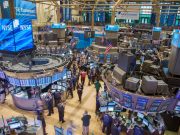The right stocks can make you rich and change your life.
The wrong stocks, though… They can do a whole lot more than just “underperform.” If only! They can eviscerate your wealth, bleeding out your hard-won profits.
They’re pure portfolio poison.
Surprisingly, not many investors want to talk about this. You certainly don’t hear about the danger in the mainstream media – until it’s too late.
That’s not to suggest they’re obscure companies – some of the “toxic stocks” I’m going to name for you are in fact regularly in the headlines for other reasons, often in glowing terms.
I’m going to run down the list and give you the chance to learn the names of three companies I think everyone should own instead.
But first, if you own any or all of these “toxic stocks,” sell them today…
AT&T (T) – Reassessing Amidst Persistent Challenges
AT&T’s latest quarterly results have brought some concerning trends to light, particularly within its core fiber-optic business. The telecommunications giant reported a second-quarter earnings per share of 57 cents, aligning with forecasts but marking a 10% decline from the previous year. More notably, its revenue slightly missed expectations at $29.80 billion, down 0.4% year-over-year. This miss was largely attributed to its underperforming fiber-optic segment, which added just 239,000 customers—falling short of the anticipated 248,600.
Despite these challenges, AT&T has maintained its full-year earnings guidance, projecting optimism in its broadband revenue growth of about 7%. However, the persistent issues in key areas of growth, coupled with a stock decline of 26% over the past five years, suggest deeper systemic problems. This chronic underperformance raises valid concerns about the company’s ability to compete effectively in the rapidly evolving telecommunications landscape.
Given these factors, investors may need to reassess their stake in AT&T. The company’s struggle to revitalize its core operations and its ongoing market underperformance could potentially limit future returns. In a sector where technological agility and innovation are crucial, AT&T’s current trajectory may not meet the growth and stability criteria that long-term investors seek. Considering the broader market dynamics, there might be more dynamic opportunities available that align better with growth-focused investment strategies.
SunPower (SPWR) – Heading Towards Potential Collapse
SunPower’s recent dramatic downturn presents a stark warning for investors. The company’s decision to halt new leases, installations, and shipments has triggered a precipitous 70% drop in its stock price, signaling deep underlying issues that might not be surmountable. Following this announcement, the stock plunged further, totaling a 93% decrease, which prompted Guggenheim Securities to slash its price target to $0—effectively labeling SunPower’s equity as potentially worthless.
The dire assessment by Guggenheim analysts suggests a possible winddown of operations, which could lead to asset sales and eventual delisting from the stock exchange. Adding to the concern, JPMorgan cites indefinite suspension activities due to alarming cash flow problems, a weakening balance sheet, and issues with regulatory compliance, painting a grim future for the company. Piper Sandler has even stopped covering the stock, indicating a lack of confidence in its prospects.
In the broader context, the residential solar sector has been under pressure from high interest rates, an oversupply in the market, and ongoing economic and political turbulence. Although the Inflation Reduction Act previously injected some optimism into the sector with tax credits, the effect appears to have waned, with SunPower not positioned to benefit in its current state.
For investors, the overwhelming consensus among top analysts and the severe stock performance suggest that SunPower is a stock to avoid. The risks far outweigh potential gains, making it prudent to consider more stable opportunities in the energy sector. SunPower’s challenges seem insurmountable, pointing to a scenario where distancing from this investment could protect your portfolio from further losses.
CrowdStrike (CRWD) – Considerations Amid Technical Challenges and High Valuation
CrowdStrike, a notable leader in the cybersecurity arena with its cloud-delivered endpoint and cloud workload protection platforms, is at a crossroads that could impact investor confidence. Recently, the company encountered a significant hurdle—a technical glitch that led to a global IT outage. This incident has not only questioned the reliability of CrowdStrike’s software but also exposed the company to potential financial liabilities as businesses around the world were disrupted.
Although CrowdStrike acted swiftly to rectify the issue, the repercussions of this event could linger, potentially tarnishing its reputation and affecting its financial performance. The immediate effects have already been felt in the stock’s performance, prompting investors to reassess the stability and future growth prospects of their holdings.
Adding to the concerns is CrowdStrike’s current market valuation. With a forward price-to-earnings (PE) ratio of 346x, the stock is priced substantially above the industry average. This premium is notably high even when considering CrowdStrike’s strong historical performance and leadership in the cybersecurity space. This valuation starkly contrasts with that of other top players in the field, such as Palo Alto Networks and Fortinet, who are trading at more conservative multiples and continue to aggressively expand their market presence.
Given the highly competitive nature of the cybersecurity market, CrowdStrike’s elevated valuation and recent operational hiccup could put additional pressure on the company. To maintain its market share, substantial investments in sales and marketing may become necessary, potentially impacting profit margins.For investors, these factors combined suggest that it may be prudent to reconsider their positions in CrowdStrike. The current market dynamics and internal challenges could hamper the company’s ability to sustain its premium valuation, especially if further reliability issues arise or if competition intensifies. Those holding CRWD stock may want to evaluate the risk/reward scenario in this evolving landscape, considering whether the potential for future growth justifies the ongoing investment amid heightened uncertainties











